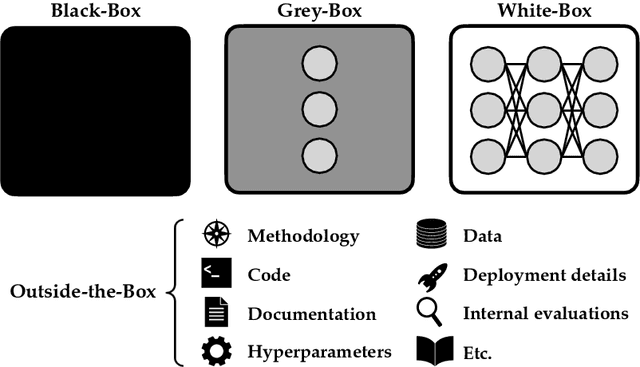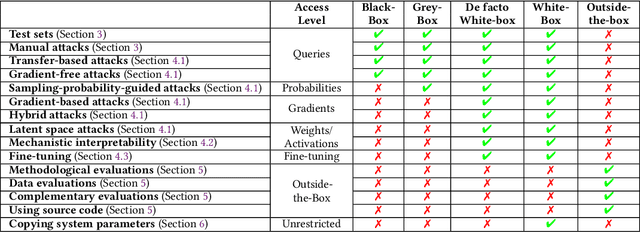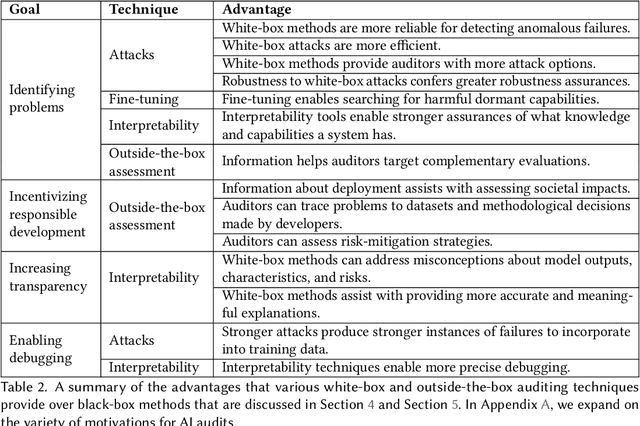Carson Ezell
Incident Analysis for AI Agents
Aug 19, 2025Abstract:As AI agents become more widely deployed, we are likely to see an increasing number of incidents: events involving AI agent use that directly or indirectly cause harm. For example, agents could be prompt-injected to exfiltrate private information or make unauthorized purchases. Structured information about such incidents (e.g., user prompts) can help us understand their causes and prevent future occurrences. However, existing incident reporting processes are not sufficient for understanding agent incidents. In particular, such processes are largely based on publicly available data, which excludes useful, but potentially sensitive, information such as an agent's chain of thought or browser history. To inform the development of new, emerging incident reporting processes, we propose an incident analysis framework for agents. Drawing on systems safety approaches, our framework proposes three types of factors that can cause incidents: system-related (e.g., CBRN training data), contextual (e.g., prompt injections), and cognitive (e.g., misunderstanding a user request). We also identify specific information that could help clarify which factors are relevant to a given incident: activity logs, system documentation and access, and information about the tools an agent uses. We provide recommendations for 1) what information incident reports should include and 2) what information developers and deployers should retain and make available to incident investigators upon request. As we transition to a world with more agents, understanding agent incidents will become increasingly crucial for managing risks.
Multi-Agent Risks from Advanced AI
Feb 19, 2025



Abstract:The rapid development of advanced AI agents and the imminent deployment of many instances of these agents will give rise to multi-agent systems of unprecedented complexity. These systems pose novel and under-explored risks. In this report, we provide a structured taxonomy of these risks by identifying three key failure modes (miscoordination, conflict, and collusion) based on agents' incentives, as well as seven key risk factors (information asymmetries, network effects, selection pressures, destabilising dynamics, commitment problems, emergent agency, and multi-agent security) that can underpin them. We highlight several important instances of each risk, as well as promising directions to help mitigate them. By anchoring our analysis in a range of real-world examples and experimental evidence, we illustrate the distinct challenges posed by multi-agent systems and their implications for the safety, governance, and ethics of advanced AI.
The AI Agent Index
Feb 03, 2025



Abstract:Leading AI developers and startups are increasingly deploying agentic AI systems that can plan and execute complex tasks with limited human involvement. However, there is currently no structured framework for documenting the technical components, intended uses, and safety features of agentic systems. To fill this gap, we introduce the AI Agent Index, the first public database to document information about currently deployed agentic AI systems. For each system that meets the criteria for inclusion in the index, we document the system's components (e.g., base model, reasoning implementation, tool use), application domains (e.g., computer use, software engineering), and risk management practices (e.g., evaluation results, guardrails), based on publicly available information and correspondence with developers. We find that while developers generally provide ample information regarding the capabilities and applications of agentic systems, they currently provide limited information regarding safety and risk management practices. The AI Agent Index is available online at https://aiagentindex.mit.edu/
Visibility into AI Agents
Feb 04, 2024

Abstract:Increased delegation of commercial, scientific, governmental, and personal activities to AI agents -- systems capable of pursuing complex goals with limited supervision -- may exacerbate existing societal risks and introduce new risks. Understanding and mitigating these risks involves critically evaluating existing governance structures, revising and adapting these structures where needed, and ensuring accountability of key stakeholders. Information about where, why, how, and by whom certain AI agents are used, which we refer to as visibility, is critical to these objectives. In this paper, we assess three categories of measures to increase visibility into AI agents: agent identifiers, real-time monitoring, and activity logging. For each, we outline potential implementations that vary in intrusiveness and informativeness. We analyze how the measures apply across a spectrum of centralized through decentralized deployment contexts, accounting for various actors in the supply chain including hardware and software service providers. Finally, we discuss the implications of our measures for privacy and concentration of power. Further work into understanding the measures and mitigating their negative impacts can help to build a foundation for the governance of AI agents.
Black-Box Access is Insufficient for Rigorous AI Audits
Jan 25, 2024


Abstract:External audits of AI systems are increasingly recognized as a key mechanism for AI governance. The effectiveness of an audit, however, depends on the degree of system access granted to auditors. Recent audits of state-of-the-art AI systems have primarily relied on black-box access, in which auditors can only query the system and observe its outputs. However, white-box access to the system's inner workings (e.g., weights, activations, gradients) allows an auditor to perform stronger attacks, more thoroughly interpret models, and conduct fine-tuning. Meanwhile, outside-the-box access to its training and deployment information (e.g., methodology, code, documentation, hyperparameters, data, deployment details, findings from internal evaluations) allows for auditors to scrutinize the development process and design more targeted evaluations. In this paper, we examine the limitations of black-box audits and the advantages of white- and outside-the-box audits. We also discuss technical, physical, and legal safeguards for performing these audits with minimal security risks. Given that different forms of access can lead to very different levels of evaluation, we conclude that (1) transparency regarding the access and methods used by auditors is necessary to properly interpret audit results, and (2) white- and outside-the-box access allow for substantially more scrutiny than black-box access alone.
The Scientific Investigation of Unidentified Aerial Phenomena (UAP) Using Multimodal Ground-Based Observatories
May 31, 2023Abstract:(Abridged) Unidentified Aerial Phenomena (UAP) have resisted explanation and have received little formal scientific attention for 75 years. A primary objective of the Galileo Project is to build an integrated software and instrumentation system designed to conduct a multimodal census of aerial phenomena and to recognize anomalies. Here we present key motivations for the study of UAP and address historical objections to this research. We describe an approach for highlighting outlier events in the high-dimensional parameter space of our census measurements. We provide a detailed roadmap for deciding measurement requirements, as well as a science traceability matrix (STM) for connecting sought-after physical parameters to observables and instrument requirements. We also discuss potential strategies for deciding where to locate instruments for development, testing, and final deployment. Our instrument package is multimodal and multispectral, consisting of (1) wide-field cameras in multiple bands for targeting and tracking of aerial objects and deriving their positions and kinematics using triangulation; (2) narrow-field instruments including cameras for characterizing morphology, spectra, polarimetry, and photometry; (3) passive multistatic arrays of antennas and receivers for radar-derived range and kinematics; (4) radio spectrum analyzers to measure radio and microwave emissions; (5) microphones for sampling acoustic emissions in the infrasonic through ultrasonic frequency bands; and (6) environmental sensors for characterizing ambient conditions (temperature, pressure, humidity, and wind velocity), as well as quasistatic electric and magnetic fields, and energetic particles. The use of multispectral instruments and multiple sensor modalities will help to ensure that artifacts are recognized and that true detections are corroborated and verifiable.
* This paper is published in the Journal of Astronomical Instrumentation, 12(1), 2340006 (2023) https://doi.org/10.1142/S2251171723400068
SkyWatch: A Passive Multistatic Radar Network for the Measurement of Object Position and Velocity
May 31, 2023



Abstract:(Abridged) Quantitative three-dimensional (3D) position and velocity estimates obtained by passive radar will assist the Galileo Project in the detection and classification of aerial objects by providing critical measurements of range, location, and kinematics. These parameters will be combined with those derived from the Project{\textquoteright}s suite of electromagnetic sensors and used to separate known aerial objects from those exhibiting anomalous kinematics. SkyWatch, a passive multistatic radar system based on commercial broadcast FM radio transmitters of opportunity, is a network of receivers spaced at geographical scales that enables estimation of the 3D position and velocity time series of objects at altitudes up to 80km, horizontal distances up to 150km, and at velocities to {\textpm}2{\textpm}2km/s ({\textpm}6{\textpm}6Mach). The receivers are designed to collect useful data in a variety of environments varying by terrain, transmitter power, relative transmitter distance, adjacent channel strength, etc. In some cases, the direct signal from the transmitter may be large enough to be used as the reference with which the echoes are correlated. In other cases, the direct signal may be weak or absent, in which case a reference is communicated to the receiver from another network node via the internet for echo correlation. Various techniques are discussed specific to the two modes of operation and a hybrid mode. Delay and Doppler data are sent via internet to a central server where triangulation is used to deduce time series of 3D positions and velocities. A multiple receiver (multistatic) radar experiment is undergoing Phase 1 testing, with several receivers placed at various distances around the Harvard{\textendash}Smithsonian Center for Astrophysics (CfA), to validate full 3D position and velocity recovery.
* This paper is published in the Journal of Astronomical Instrumentation, 12(1) (2023) 10.1142/S2251171723400044 The abstract has been updated
 Add to Chrome
Add to Chrome Add to Firefox
Add to Firefox Add to Edge
Add to Edge